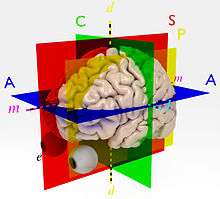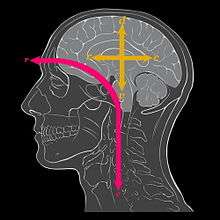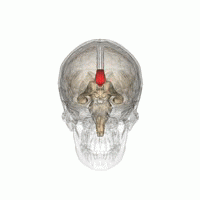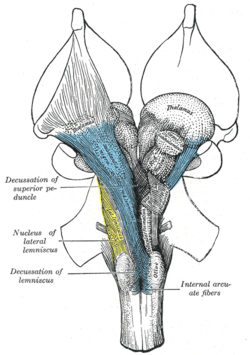Glossary of neuroanatomy
 |
| This article is part of a series on |
| Anatomical terminology |
|---|
| Motion |
| Location |
| Muscle |
| Bone |
| Neuroanatomy |
This article attempts to provide definitions to a number of anatomical terminology, definitions and abbreviations, pertinent to the description of the Central Nervous System, particularly in humans. It aims to provide further information to the description of orientation in neuroanatomy.
Anatomical localisation
To understand the terms used for anatomical localisation, consider an animal with a straight CNS, such as a fish or lizard. In such animals the terms "rostral", "caudal", "ventral" and "dorsal" mean respectively towards the rostrum, towards the tail, towards the belly and towards the back. For a full discussion of those terms, see anatomical terms of location. For many purposes of anatomical description, positions and directions are relative to the standard anatomical planes and axes. Such reference to the anatomical planes and axes is called the stereotactic approach.
However, in humans and most other primates the axis of the CNS is bent and the face (rostrum) is no longer at one end of the rostro-caudal axis of the body. The erect human posture demands modifications of the terms and meanings of the descriptions that apply to most vertebrates, but even greater compromises are necessary in describing the central nervous system. The planes defining the anatomical localisation of the human brain are similar to those that apply to the body, but with certain major differences that reflect the distortion of the brains of the Hominidae in their adaptation to a bipedal way of life. These are shown in the accompanying illustrations and annotations. In particular the anatomical planes and axes that apply to most vertebrate nervous systems need considerable modification before they can be of use in describing the human brain. For example in reference to the human brain, "rostral" still means "towards the face", or at any rate, the interior of the cranial cavity just behind the face. However, in the brain "caudal" means not "towards the tail", but "towards the back of the cranial cavity". Alternative terms for this rostro-caudal axis of the brain include medial or antero-posterior axis.
"Dorsal" means "in the direction away from the spinal cord i.e. in the direction of the roof of the cranial cavity". "Ventral" means downwards towards floor of the cranial cavity and thence to the body. They lie on the superior-inferior or Dorsoventral axis. The third axis passes through the ears, and is called the left-right, or lateral axis.
These three axes of the human brain match the three planes within which they lie, even though the terms for the planes have not been changed from the terms for the bodily planes. The most commonly used reference planes are:
- Axial, the plane that is horizontal and parallel to the axial plane of the body in the standard anatomical position. It contains (and thus is defined by) the lateral and the medial axes of the brain.
- Coronal, a vertical plane that passes through both ears, and contains the lateral and dorsoventral axes.
- Sagittal, a vertical plane that passes from between the nostrils, and between the cerebral hemispheres, dividing the brain into left and right halves. It contains the dorsoventral and medial axes of the brain. A parasagittal plane is any plane parallel to the sagittal plane.
A

Three axes:
- d: Axial, Superior-inferior or Dorsoventral axis (yellow)
- l: Left-right, or Lateral axis (cyan, blue-green)
- m: Medial, Antero-posterior or Rostral-to-caudal axis (magenta)
- A: Axial, Transverse or Horizontal plane (blue), containing the lateral axis and also the Medial axis
- C: Coronal plane (green), containing the axial axis and the lateral axis
- S: Sagittal plane (red), containing the axial axis and the medial axis
- e: The eye at the anterior end of the brain
- P: A Parasagittal plane (yellow) through one eye; parasagittal planes comprise the class of planes parallel to (and therefore lateral to) the sagittal plane.
- Afferent
- An afferent nerve fiber is a fibre originating at the present point. For example a striatal afferent is an afferent originating at the striatum. See Efferent.


Red axis shows how the head bent forward as the back pointed upwards:
c: Caudal
r: Rostral
Yellow axes show the conventions for naming directions in the brain itself:
c: Caudal (though not tail direction),
d: Dorsal
r: Rostral (effectively unchanged)
v: Ventral (though not belly direction)
- Anatomy
- The study of the body. The determination of the regions in an organism that are to be considered its "parts". From the Latin anatomia, dissection, from the Greek, anatome, where ana means up, and temnein means to cut.
- Anatomical Position
- The standard reference position for the body in anatomy. Body standing erect and facing observer, arms at sides, palms forward.
- Annectent Gyrus
- A small gyrus hidden in the depth of a sulcus. Also known as transition gyrus. See Gyrus, Sulcus.
- Anterior
- The front of the body or body part.
- Axial plane
- A plane orthogonal to the superior-inferior axis. Alternative terms include transverse plane and horizontal plane. In the human brain, in contrast to that of lizards, the axial plane includes the left-to-right axis, and the rostral-to-caudal axis (the axis between the back of the head and the face).
C
- CalcS
- Calcarine Sulcus.
- Caudal
- Towards the tail. See Anatomical localisation.
- CC
- Corpus Callosum.

.
- Chiasm (also Chiasma)
- Amounts to much the same as decussation, an X-shaped crossing of nerve fibres between the cerebral hemispheres. The major example in the human brain is the Optic chiasm. The main difference between such a chiasm and a decussation is that not all nerve fibres entering the chiasm cross over, whereas in a decussation there should be complete crossing over.
- CingS
- Cingulate Sulcus.
- Commissure
- A group of nerve fibres crossing the sagittal plane mainly parallel to the lateral axis and therefore without forming a cross-shape. Contrast this with a Chiasm or a Decussation, in which the source and destination of each bundle are not on the same lateral axis, so that the two bundles cross each other obliquely. In the Eutherian brain the nerve fibre tracts across the medial longitudinal fissure, that form commissures between the two cerebral hemispheres, are the anterior commissure, posterior commissure, corpus callosum, hippocampal commissure (commissure of fornix), and habenular commissure. The spinal cord contains a commissure as well: the anterior white commissure.
- Contralateral
- 1: At the more-or-less corresponding position on the laterally opposite side of the sagittal plane, i.e. right instead of left or left instead of right, as in reference to an infection in one tonsil spreading to the contralateral tonsil
- 2: Contralateral also might refer to the functionally opposite side in a more general sense, as when injuries to one side of the head produce contralateral paralysis or convulsions in the body.
- cf. Ipsilateral
- Coronal
- A plane orthogonal to the anterior-posterior axis; it therefore contains the lateral axis and the dorsoventral axis. In the brain, it shows left and right, the top of the head and the neck.
- CS
- Central Sulcus.
D

- Decussation
- where nerve fibers obliquely cross from one lateral part of the brain to the other, that is to say they cross at a level other than their origin. Contrast with Commissure cf. also Chiasm
- Distal
- Farther away from the torso in general, or the axial axis in particular. cf. Proximal
- Dorsal
- Pertaining to the back or upper side, depending on context. In most vertebrates with a horizontal backbone "dorsal" means the back, is in, for example "horseback"; however, in the human brain "dorsal" means upwards towards the top of the head or cranium, and away from the spinal cord where it exits the skull at the foramen magnum in the occipital bone.
- DTI
- Diffusion tensor imaging.
- DWI
- Diffusion weighted imaging.
E
- Efferent
- An efferent fibre is a fibre that arrives at the present point. For example, a cortical efferent is a fibre coming from somewhere else, and arriving to the cortex. Note that that is the opposite of the direction in which the nerve fibre conducts signals. See also Afferent.
- Endomysium
- Thin connective tissue surrounding each muscle cell.
- EPI
- Echo planar imaging.
F

The corpus callosum is the major example of an interhemispheric commissure in the human brain
- Fissure
- 1: A deep groove produced by opercularisation. An example is the Sylvian Fissure.
- 2: A deep groove produced by the differentiation of the telencephalic vesicles. An example is the Medial longitudinal fissure, also known as the interhemispheric fissure.
| Look up fundus in Wiktionary, the free dictionary. |
- Fundus
- pl Fundi. The bottom of an inward fold. See Sulcal fundus, Sulcus.
G
- Gyral Crown
- The top of a Gyrus. See Sulcal Wall, Sulcal Fundus, Gyrus, Sulcus.
- Gyrus
- pl. Gyri. An outward fold (a hill), as for example the gyri of the cerebellar or cerebral cortex. Important gyri are the precentral and postcentral gyri, for example.
H
- Horizontal
- A plane orthogonal to the superior-inferior axis. In the brain, horizontal planes would cut across the brain at right angles to the main axis of the body (the spinal column). A horizontal plane could cut across both ears and the nose at the same time. Equivalent to Axial. See Anatomical localisation.
I
- IFG
- Inferior frontal gyrus.
- IFS
- Inferior frontal sulcus.
- Inferior
- Away from the top of the head; downwards. Usually compared with another structure closer to the head (the lips are inferior to the nose)
- Interhemispheric
- Between or connecting the cerebral hemispheres (for instance in "interhemispheric commissure")
- IPS
- Intraparietal sulcus.
- Ipsilateral
- At the same side, as in the human appendix vermiformis being ipsilateral with the liver; cf. Contralateral.
- ITS
- Inferior temporal sulcus.
L
- Lacrimal bone
- A skull bone; the smallest and most fragile bone of the face; roughly the size of the little fingernail.
- Lateral
- To the side, away from the midline of the body.
M
- Medial
- At the middle. For example, the medial cortex is the cortex near the plane that divides left and right hemispheres;
- Mesencephalic duct
- aka Cerebral aqueduct or Aqueduct of Sylvius, is part of the ventricular system of the CNS.
- Mesial
- Directed towards the middle.
- MRI
- Magnetic Resonance Imaging.
- Myofibril
- Rodlike bundle of contractile myofilaments in the cytoplasm of a skeletal muscle cell. Made of repeating segments called Sarcomeres.
O

- Opercularisation
- the formation of the cerebral opercula during the intrauterine development of the brain.
- Operculum
- pl. Opercula: In the context of neuroanatomy, "operculum" generally refers to a cerebral operculum, a part of the cerebral cortex overlying parts of the frontal, parietal, and temporal lobes adjacent to the sylvian fissure and over the insula. The operculum includes cortical regions concerned with the perception of spoken language and with motor functions required for competent speech.[1]
- Optic chiasm
- The major chiasm in the human brain, by which the information from the visual field of each eye is directed to the visual cortex of the appropriate cerebral hemisphere.
P
- Palmar
- Referring to the palm of the hand.
- Parasagittal
- A plane parallel to the sagittal plane (which divides left and right sides). See Sagittal, Anatomical localisation.
- Plantar
- Referring to the sole of the foot.
- PC
- Posterior Commissure.
- Physiology
- The study of body function.
- Prone
- Lying face down.
- Proximal
- Closer to the torso or, more generally, to the axial axis.
- PV
- Prefrontal Cortex.
- postCS
- Postcentral Sulcus.
- preCS
- Precentral Sulcus.
- Pu
- Putamen.
- Posterior
- Toward the back of the body or body part; synonymous with caudal
R
- Rostral
- Towards the face. See Anatomical localisation.
S
- Sagittal
- A plane that divides the left and right sides of a bilateral organism or organ such as the brain. See also Parasagittal, Anatomical localisation.
- Sarcoplasm
- The cytoplasm of a muscle cell.
- Sensory decussation (also decussation of the lemniscus)
- where axons from the gracile nucleus and cuneate nucleus cross over.
- Sulcal Fundus
- plural: Sulcal Fundi. The bottom of a sulcus, an inward fold (mainly of the cerebral cortex). See Sulcus and Fundus.
- Sulcal Wall
- One of the two sides of a sulcus (an inward fold). See Sulcus.
- Sulcus
- pl. Sulci. An inward fold (a valley), as for example the central and calcarine sulci of the cerebral cortex. Examples of important sulci are the central sulcus (CS) and the calcarine sulcus (CalcS). See Sulcus (morphology). See also Fissure.
- Superior
- Toward the head.
- Supine
- Lying face up.
T
- Tendon
- fibrous connective tissue in the form of cord attaching muscle to bone.
- Th
- Thalamus.
- Transition Gyrus
- see Annectent gyrus, Gyrus, Sulcus.
V
- Ventral
- Towards the belly. See Anatomical localisation.
Z
- Zygomatic arch
- Forms the cheek bone.
References
- ↑ Cheng-Yu Chen, Robert A. Zimmerman, Scott Faro, Beth Parrish, Zhiyue Wang, Larissa T. Bilaniuk, Ting-Ywan Chou. MR of the Cerebral Operculum. AJNR 16:1677–1687, Sep 1995 0195-6108/95/1608–1677 American Society of Neuroradiology